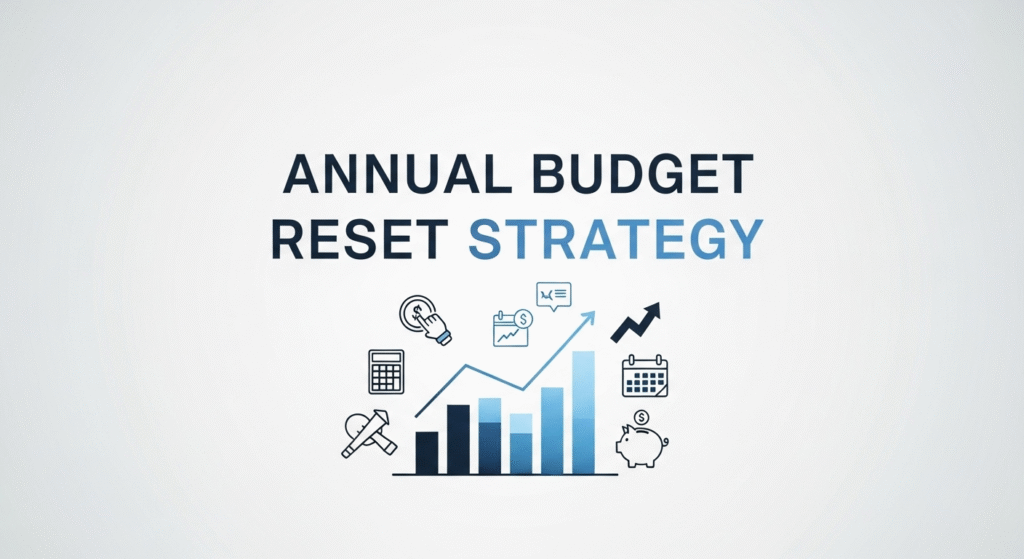
Annual Budget Reset Strategy is a powerful way to refresh your finances and start the year with purpose. It allows you to look back at your previous year’s spending, identify financial wins, and learn from mistakes. By reviewing where your money went, you can understand your habits better and make informed decisions for the future. This process brings awareness and clarity to your financial life.
With an Annual Budget Reset Strategy, you can set new goals, adjust your budget, and realign your money with your current priorities. It helps you prepare for upcoming expenses, build stronger savings, and create a realistic plan for long-term success.
Reviewing the Past Year’s Finances

The first step in your Annual Budget Reset Strategy is reviewing the past year’s finances to understand where your money went and how your financial habits shaped your results. Start by gathering your income records, expense summaries, and bank statements. Analyze how much you earned, how much you saved, and where your biggest expenses occurred. This helps you get a clear financial picture and identify patterns that influenced your spending throughout the year.
Look for the areas that worked well; perhaps you stayed consistent with savings or reduced unnecessary costs. These are your financial wins, and they deserve recognition. However, it’s equally important to identify what didn’t go as planned. Maybe your grocery spending exceeded the budget or you didn’t meet your savings goal. The Annual Budget Reset Strategy encourages learning from both wins and mistakes.
As you reflect, categorize your spending habits into essentials, wants, and wasted costs. This process helps highlight opportunities for better money management in the year ahead. If you experienced any income fluctuations or emergencies, note how they impacted your financial stability. The goal is not to criticize yourself but to build awareness and use it for improvement.
Setting Clear Financial Goals for the New Year

Once you’ve reviewed the past year, the next phase of the Annual Budget Reset Strategy is setting clear and achievable financial goals. Without direction, budgeting can feel random. Start by defining what you truly want to accomplish, whether it’s paying off debt, growing your savings, investing in education, or purchasing your first home.
Divide your goals into short-term (1–3 months), mid-term (6–12 months), and long-term (1–5 years) categories. Short-term goals might include saving for a small vacation, while long-term ones may focus on building an emergency fund or retirement savings. The Annual Budget Reset Strategy encourages aligning these goals with your life priorities. For instance, if becoming debt-free brings peace of mind, prioritize it.
Be realistic yet ambitious when creating milestones. Use specific targets like “Save $500 by March” instead of vague ones like “Save more money.” This clarity helps track progress easily.
Visual tools such as trackers, charts, or budgeting apps can make goal monitoring fun and rewarding. The Annual Budget Reset Strategy also recommends reviewing your goals every quarter to stay accountable and adjust as needed.
Creating a Fresh Budget Plan for the Year Ahead
With your goals in place, the next step in the Annual Budget Reset Strategy is designing a new and improved budget plan for the year. Begin by adjusting your income and expense categories based on last year’s insights. If your income changed or certain costs increased, update the numbers to reflect your current situation.
Start by dividing your budget into main categories, essentials (rent, bills, groceries), savings, and discretionary spending. The Annual Budget Reset Strategy recommends using the 50/30/20 rule: allocate 50% of your income to needs, 30% to wants, and 20% to savings or debt repayment. You can also try zero-based budgeting, where every dollar is assigned a purpose before the month begins.
Add room for emergencies, vacations, and investments. Even small contributions to each category can lead to major long-term benefits. Track your spending weekly or biweekly to prevent surprises at month-end.
The Annual Budget Reset Strategy also encourages using digital tools or finance apps for convenience. Automating bill payments and savings transfers saves time and reduces stress.
Smart Tools and Templates for Annual Budget Reset

Technology can simplify your Annual Budget Reset Strategy dramatically. Budgeting apps, spreadsheets, and printable templates make it easy to stay organized. Start by choosing tools that suit your style — some people prefer digital apps, while others like printable planners they can physically write in.
Popular budgeting apps such as YNAB (You Need A Budget), Mint, and EveryDollar allow you to track income, expenses, and savings automatically. Spreadsheets in Google Sheets or Excel are ideal for customizing categories. The Annual Budget Reset Strategy works best when your tools are easy to access and update regularly.
Printable templates are also great for visual tracking. You can hang a yearly budget tracker in your workspace or home to stay motivated. Additionally, using automation for bills, investments, and savings can eliminate human error and ensure you never miss payments.
Automation aligns perfectly with the Annual Budget Reset Strategy, helping you stay consistent without daily effort.
Cutting Unnecessary Costs and Reallocating Funds
A key component of the Annual Budget Reset Strategy is cutting unnecessary expenses. Over time, small recurring costs like unused subscriptions, expensive coffee habits, or premium services — add up and limit your savings potential. Review your spending list and highlight charges that no longer serve a purpose.
Next, negotiate with providers for better deals on utilities, insurance, or internet services. Many companies offer discounts if you ask or switch to a more suitable plan. The Annual Budget Reset Strategy helps you redirect this saved money toward more meaningful goals, like investments or an emergency fund.
Categorize your expenses into three groups: must-haves, nice-to-haves, and unnecessary. Eliminating or reducing the last category can create significant monthly savings.
The Annual Budget Reset Strategy also encourages adopting mindful spending habits. For example, try waiting 24 hours before making non-essential purchases — this simple trick helps avoid impulse buying.
Building Habits for a Successful Financial Year
The final and most empowering step in the Annual Budget Reset Strategy is building consistent habits that keep your finances on track all year long. Start by scheduling monthly check-ins to review your income, expenses, and progress toward annual goals. This helps you stay aware and make small corrections early.
Quarterly reviews are also vital to ensure accuracy and reflect any life changes, such as new income streams or expenses. The Annual Budget Reset Strategy turns these check-ins into an empowering ritual rather than a chore. Celebrate your wins even small ones like sticking to your budget or saving an extra $50. Visual progress trackers, savings jars, or goal charts can keep motivation high.
Lastly, stay consistent. The Annual Budget Reset Strategy is not about perfection but progress. When you follow your plan regularly, budgeting becomes second nature, helping you maintain control and confidence throughout the year.
Conclusion
The Annual Budget Reset Strategy is more than just a once-a-year financial task. It’s a chance to take full control of your money and set yourself up for success. By reviewing the past year’s finances, setting clear goals, creating a fresh budget, and using smart tools, you build a solid foundation for financial stability and growth.
This strategy helps you stay mindful of your money, make better spending decisions, and align your finances with your personal goals. With consistency and discipline, the Annual Budget Reset Strategy can transform your budgeting routine into a powerful habit that keeps your financial life organized all year long.
Remember, progress doesn’t happen overnight. But every small adjustment, saving goal, and spending decision adds up to meaningful change. With the Annual Budget Reset Strategy, you’re not just managing money you’re mastering it for a better, more confident financial future.
FAQs
What is an Annual Budget Reset Strategy?
The Annual Budget Reset Strategy is a yearly financial planning method that helps you review income, spending, and savings from the past year. It allows you to evaluate what worked, fix mistakes, and plan smarter for the next year. By setting new goals and refreshing your budget, the Annual Budget Reset Strategy ensures you stay organized, reduce waste, and make confident money decisions that support long-term financial success.
Why is the Annual Budget Reset Strategy important?
The Annual Budget Reset Strategy is important because it helps you realign your finances with your goals. Over time, expenses and priorities change, and this reset helps you adapt. It ensures your budget fits your current lifestyle, boosts savings, and controls spending. By analyzing last year’s habits, the Annual Budget Reset Strategy allows you to correct overspending and plan better for the months ahead, keeping your money working efficiently all year.
How often should I review my budget after the reset?
Although the Annual Budget Reset Strategy is completed once a year, monthly or quarterly reviews are highly recommended. Regular check-ins help you track your goals, manage new expenses, and adjust your spending as needed. Using the Annual Budget Reset Strategy with ongoing reviews keeps your finances balanced and ensures you stay consistent throughout the year, allowing for small improvements that make a big impact on your financial stability and savings growth.
